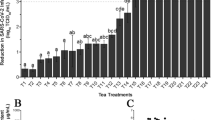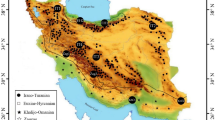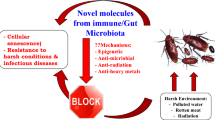Abstract
Antibacterial properties of honey largely depend on the accumulation of hydrogen peroxide (H2O2), which is generated by glucose oxidase (GOX)-mediated conversion of glucose in diluted honey. However, honeys exhibit considerable variation in their antibacterial activity. Therefore, the aim of the study was to identify the mechanism behind the variation in this activity and in the H2O2 content in honeys associated with the role of GOX in this process. Immunoblots and in situ hybridization analyses demonstrated that gox is solely expressed in the hypopharyngeal glands of worker bees performing various tasks and not in other glands or tissues. Real-time PCR with reference genes selected for worker heads shows that the gox expression progressively increases with ageing of the youngest bees and nurses and reached the highest values in processor bees. Immunoblot analysis of honey samples revealed that GOX is a regular honey component but its content significantly varied among honeys. Neither botanical source nor geographical origin of honeys affected the level of GOX suggesting that some other factors such as honeybee nutrition and/or genetic/epigenetic factors may take part in the observed variation. A strong correlation was found between the content of GOX and the level of generated H2O2 in honeys except honeydew honeys. Total antibacterial activity of most honey samples against Pseudomonas aeruginosa isolate significantly correlated with the H2O2 content. These results demonstrate that the level of GOX can significantly affect the total antibacterial activity of honey. They also support an idea that breeding of novel honeybee lines expressing higher amounts of GOX could help to increase the antibacterial efficacy of the hypopharyngeal gland secretion that could have positive influence on a resistance of colonies against bacterial pathogens.





Similar content being viewed by others
References
Akagawa M, Shigemitsu T, Suyama K (2003) Production of hydrogen peroxide by polyphenols and polyphenol-rich beverages under quasi-physiological conditions. Biosci Biotechnol Biochem 67:2632–2640
Alaux C, Ducloz F, Crauser D, Le Conte Y (2010) Diet effects on honeybee immunocompetence. Biol Lett 6:562–565
Alvarez-Suarez JM, Giampieri F, Battino M (2013) Honey as a source of dietary antioxidants: structures, bioavailability and evidence of protective effects against human chronic diseases. Curr Med Chem 20:621–638
Andersen CL, Jensen JL, Ørntoft TF (2004) Normalization of real-time quantitative reverse transcription-PCR data: a model-based variance estimation approach to identify genes suited for normalization, applied to bladder and colon cancer data sets. Cancer Res 64:5245–5250
Bang LM, Bantting C, Molan PC (2003) The effects of dilution rate on hydrogen peroxide production in honey and its implications for wound healing. J Altern Complement Med 9:267–273
Bilikova K, Simuth J (2010) New criterion for evaluation of honey: quantification of royal jelly protein apalbumin 1 in honey by ELISA. J Agric Food Chem 58:8776–8781
Brudzynski K (2006) Effect of hydrogen peroxide on antibacterial activities of Canadian honeys. Can J Microbiol 52:1228–1237
Brudzynski K, Abubaker A, St-Martin L, Castle A (2011) Re-examining the role of hydrogen peroxide in bacteriostatic and bactericidal activities of honey. Front Microbiol 2:1–9
Cernak M, Majtanova N, Cernak A, Majtan J (2012) Honey prophylaxis reduces the risk of endophthalmitis during perioperative period of eye surgery. Phytother Res 26:613–616
Chen C, Campbell LT, Blair SE, Carter DA (2012) The effect of standard heat and filtration processing procedures on antimicrobial activity and hydrogen peroxide levels in honey. Front Microbiol 3:1–8
De Grandi-Hoffman G, Hagler J (2000) The flow of incoming nectar through a honey bee (Apis mellifera L.) colony as revealed by a protein marker. Insectes Soc 47:302–306
Hellemans J, Mortier G, De Paepe A, Speleman F, Vandesompele J (2007) qBase relative quantification framework and software for management and automated analysis of real-time quantitative PCR data. Genome Biol 8:R19
Kim YJ, Zitnan D, Cho KH, Mizoguchi A, Schooley D, Adams ME (2006) Endocrine programming of an innate behavior through central release of peptide cotransmitters. Proc Natl Acad Sci U S A 103:14211–14216
Klaudiny J, Bachanova K, Kohutova L, Dzurova M, Kopernicky J, Majtan J (2012) Expression of larval jelly antimicrobial peptide defensin1 in Apis mellifera colonies. Biologia 67:200–211
Kohutova L, Klaudiny J, Nadasdy R, Sediva M, Kopernicky J, Majtan J (2013) Identification and validation of reference genes for real time PCR expression studies in heads of nurse honeybees. Biologia 68:1211–1220
Kwakman PH, Te Velde AA, De Boer L, Vandenbroucke-Grauls CM, Zaat SA (2011) Two major medicinal honeys have different mechanisms of bactericidal activity. PLoS ONE 6:e17709
Li J, Feng M, Zhang Z, Pan Y (2008) Identification of the proteome complement of hypopharyngeal glands from two strains of honeybees (Apis mellifera). Apidologie 39:199–214
Liu F, Li W, Li Z, Zhang S, Chen S, Su S (2011) High-abundance mRNAs in Apis mellifera: comparison between nurses and foragers. J Insect Physiol 57:274–279
Long LH, Hoi A, Halliwell B (2010) Instability of, and generation of hydrogen peroxide by, phenolic compounds in cell culture media. Arch Biochem Biophys 501:162–169
Majtan J et al (2012) Methylglyoxal-induced modifications of significant honeybee proteinous components in manuka honey: possible therapeutic implications. Fitoterapia 83:671–677
Majtan J, Bohova J, Prochazka E, Klaudiny J (2014) Methylglyoxal may affect hydrogen peroxide accumulation in manuka honey through the inhibition of glucose oxidase. J Med Food 17:290–293
Ohashi K, Natori S, Kubo T (1999) Expression of amylase and glucose oxidase in the hypopharyngeal gland with an age-dependent role change of the worker honeybee (Apis mellifera L.). Eur J Biochem 265:127–133
Santos KS, Delazari Dos Santos L, Anita Mendes M, Monson De Souza B, Malaspina O, Palma MS (2005) Profiling the proteome complement of the secretion from hypopharyngeal gland of Africanized nurse-honeybees (Apis mellifera L.). Insect Biochem Mol Biol 35:85–91
Seeley TD (1992) The tremble dance of the honey bee: message and meanings. Behav Ecol Sociobiol 47:311–316
Vandesompele J, De Preter K, Pattyn F, Poppe B, van Roy N, De Paepe A, Speleman F (2002) Accurate normalization of real-time quantitative RT-PCR data by geometric averaging of multiple internal control genes. Genome Biol 3:R34
Vlcekova P, Krutakova B, Takac P, Kozanek M, Salus J, Majtan J (2012) Alternative treatment of gluteofemoral fistulas using honey: a case report. Int Wound J 9:100–103
White JW, Subers MH, Schepartz AI (1963) The identification of inhibine, the antibacterial factor in honey, as hydrogenperoxide and its origin in a honey glucose-oxidase system. Biochim Biophys Acta 73:57–70
Winston ML (1987) The biology of honey bees. Harvard University Press, Cambridge
Yang X, Cox-Foster DL (2005) Impact of an ectoparasite on the immunity and pathology of an invertebrate: evidence for host immunosuppression and viral amplification. Proc Natl Acad Sci U S A 102:7470–7475
Acknowledgments
We would like to thank Mr. Dusan Dedinsky and Dr. Robert Nadasdy as well as Dr. Jan Kopernicky for help at collecting of workers of particular tasks and defined ages, respectively. This work was funded by the Operational Program Research and Development and co-financed by the European Fund for Regional Development (EFRD) via grant ITMS 26240220030—“Research and development of new biotherapeutic methods and its application in some illnesses treatment”—and by the Scientific Grant Agency of the Ministry of Education of the Slovak Republic and the Slovak Academy of Sciences VEGA 2/0178/12.
Author information
Authors and Affiliations
Corresponding author
Additional information
Communicated by: Sven Thatje
Rights and permissions
About this article
Cite this article
Bucekova, M., Valachova, I., Kohutova, L. et al. Honeybee glucose oxidase—its expression in honeybee workers and comparative analyses of its content and H2O2-mediated antibacterial activity in natural honeys. Naturwissenschaften 101, 661–670 (2014). https://doi.org/10.1007/s00114-014-1205-z
Received:
Revised:
Accepted:
Published:
Issue Date:
DOI: https://doi.org/10.1007/s00114-014-1205-z




